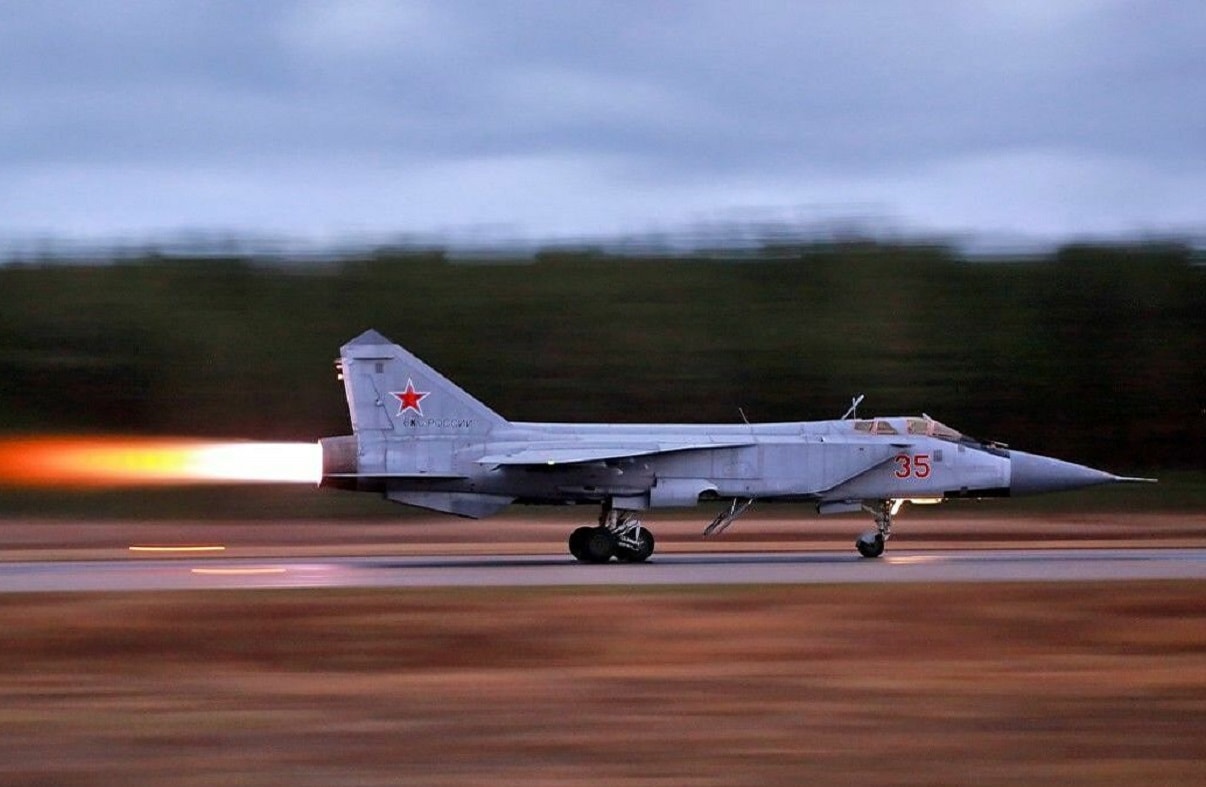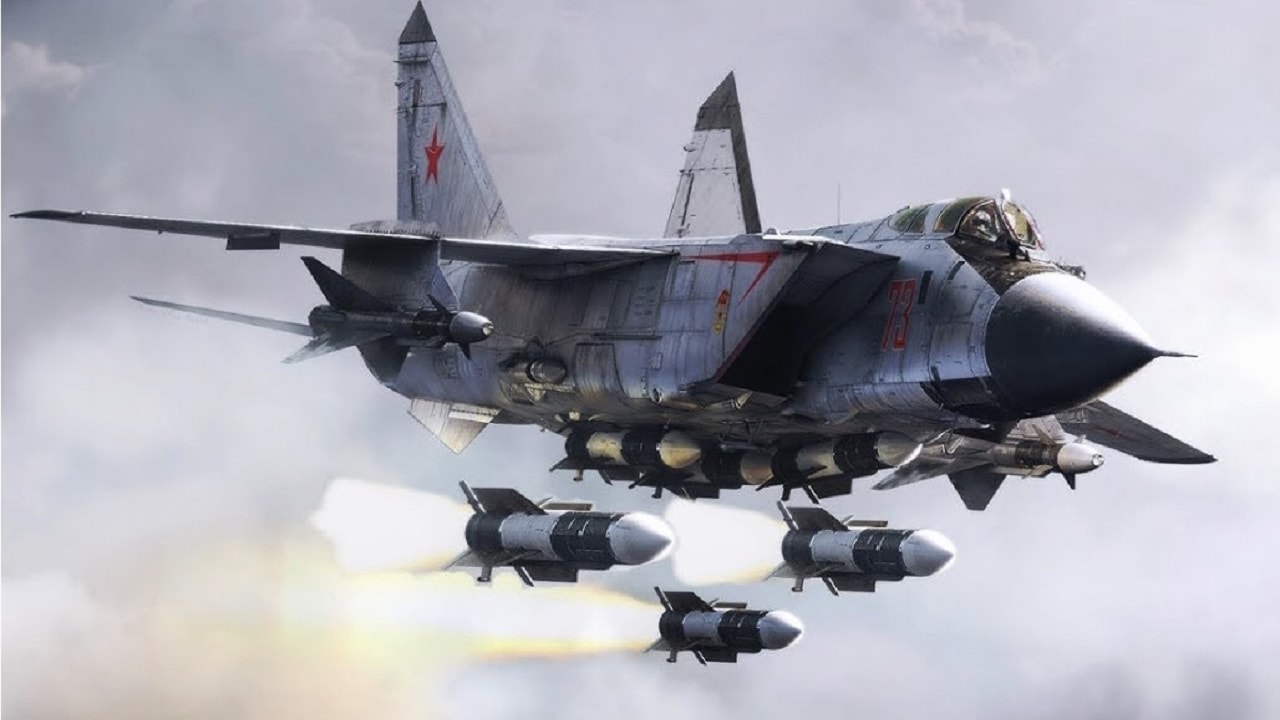Meet the MiG-31: The Soviet aerospace industry had its fair share of hits and failures. Some designs looked promising but ended up being failures in the long run.
Unfortunately for the West, the MiG-31 was not one of these failures. First built in 1975, the Mikoyan MiG-31 Foxhound is perhaps the most advanced and formidable fighter built by the Soviet Union and is still a force to be reckoned with 50 years later.
MiG-31 Explained
The Soviets had a clear mission for the MiG-31. It was designed to intercept cruise missiles and their launch aircraft by reaching the missile launch range in the shortest possible time after departing the loiter area. It was also supposed to detect and destroy low-flying cruise missiles, UAVs, and helicopters, escort strategic bombers, and provide strategic air defense in areas not covered by ground-based air defense systems.
The MiG-31’s development began in the early 1970s, with its first flight on September 16, 1975. The Mikoyan Design Bureau designed the aircraft to address the limitations of the MiG-25, particularly its lack of maneuverability at interception speeds and difficulties in low-altitude flight.
The MiG-31 incorporated several improvements, including a longer fuselage for a second crew member, a radar operator, and more sophisticated avionics. The airframe was also built using sturdier metals to allow the plane to reach supersonic speeds at lower altitudes.
One of the most significant improvements was the MiG-31’s radar system. The aircraft was equipped with the Zaslon S-800 radar, the world’s first phased-array radar integrated into a fighter. It can track multiple targets simultaneously and engage low-flying cruise missiles and bombers. This radar system gave the MiG-31 a substantial edge in detecting and intercepting long-range threats.
Russia’s Fastest Fighter
Like the MiG-25, the Foxhound is known for its incredible speeds. It can reach speeds of up to Mach 2.83, with a maximum speed of Mach 3.2 achievable under certain conditions. However, sustained flight at such high speeds risks damaging the aircraft’s engines. The MiG-31’s service ceiling is approximately 25,000 meters (82,000 feet), near the border of space, allowing it to operate at altitudes that few other aircraft can reach.
Regarding armament, the MiG-31 has four long-range R-33 missiles, a 23 mm GSh-6-23 cannon, and various other air-to-air missiles, depending on the mission requirements. The aircraft’s speed, altitude, and advanced weaponry make it a formidable interceptor capable of neutralizing a wide range of aerial threats.
The MiG-31’s Service Record
The Foxhound entered service with the Soviet Air Forces on May 6, 1981. It quickly became a cornerstone of the Soviet Union’s air defense strategy, replacing the obsolete Tu-128 as the primary long-range interceptor. The aircraft’s ability to engage targets at long distances and high altitudes threatened Western bombers and reconnaissance aircraft.
Following the collapse of the Soviet Union in 1991, the MiG-31 continued to serve in the Russian Aerospace Forces. Despite the economic challenges faced by Russia in the 1990s, the MiG-31 remained a critical component of the country’s air defense.
The aircraft has undergone several upgrades over the years, including the MiG-31BM variant, which features improved avionics, radar systems, and weapons.
Before 2022, the MiG-31 had never seen combat, only being used to patrol Soviet/Russian airspace. After the 2022 invasion of Ukraine, the Foxhound finally got a chance to distinguish itself. The MiG-31 quickly became the bane of the Ukrainian air force.

MiG-31. Image: Russian state media.
With its long-range systems, the fighter can engage Ukrainian aircraft from over 100 miles away, with Ukraine having virtually no way to stop it. The arrival of the Patriot and other Western air defense systems gave Ukraine a little breathing room. However, the Foxhound is still a substantial threat, even with Western fighter jets now available.
Carrier of the Kinzhal
In recent years, the Russian Defense Ministry has announced plans to extend the service life of the MiG-31 fleet until at least 2030. This extension involves upgrading existing airframes to increase operational hours from 2,500 to 3,500. The modernization program includes enhancements to the aircraft’s radar, avionics, and weapon systems, ensuring that the MiG-31 remains a potent interceptor for the near future.
Part of this upgrade program was integrating the Kinzhal hypersonic missile, which significantly enhanced the MiG-31’s strike capabilities. The Kinzhal missile can travel at speeds of up to Mach 10 and has a range of over 2,000 kilometers, making it a formidable weapon against ground and naval targets.
The MiG-31 has carried out several strikes against Ukraine using the Kinzhal, making it an essential tool in Moscow’s arsenal.
You Should Fear the Foxhound
Despite its age, the MiG-31 Foxhound is still very much a formidable threat to modern air forces. Its high speeds and advanced radar systems enable it to detect and intercept targets at great distances.
Its ability to carry Kinzhal missiles allows it to carry out long-range strikes against valuable targets that are exceedingly difficult to intercept. While American jets can fulfill more functions, the Foxhound has fewer roles to fulfill but fulfills them exceptionally well.
The MiG-31 is perhaps one of, if not the most dangerous fighter jets currently in Russian service.
About the Author:
Isaac Seitz, a 19FortyFive Defense Columnist, graduated from Patrick Henry College’s Strategic Intelligence and National Security program. He has also studied Russian at Middlebury Language Schools and has worked as an intelligence Analyst in the private sector.

